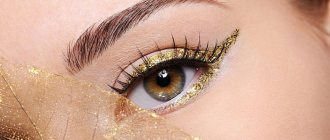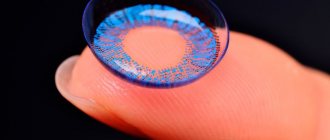Contact lenses have become a good replacement for glasses for people with poor vision. On the Internet you can find a lot of information about them, which is sometimes difficult to understand and even unreliable. What kind of corrective lenses there are, who they are not suitable for and whether they are harmful to the eyes, Tatyana Terekhina, an ophthalmologist at the 32nd City Clinical Clinic, told a correspondent of the Minsk-Novosti agency.
Photo is for illustrative purposes only, pixabay.com
In most cases, we are born farsighted, having +3.0 diopters of refraction. Only later, when the eyeball enlarges and the sharpness is adjusted, our vision becomes an ideal unit or has a pathology. Thus, some children begin to wear glasses prescribed by a doctor because they have developed farsightedness, nearsightedness or astigmatism since childhood.
From the first years at school, children have the opinion that because of their glasses they will be teased, called names and will not be invited to the company. That’s why some people don’t want to wear them from an early age, when their vision can still be corrected. This ultimately only worsens it - and without glasses it is no longer possible to lead a normal life. Vision can be completely restored only with the help of laser correction, which is done only after 18 years of age, if there are no diseases. That's when lenses come to the rescue.
— There are different contact lenses. For example, one-day clothes that need to be changed every day. Others change once a month or even once a year. And there are lenses that you can wear for a month without even taking them off! - says the ophthalmologist. “But when choosing such vision correction, many aspects need to be taken into account.
Debunking myths
Regular use of contact lenses does not cause any harm to eye health, even if you wear them for several days. For their production, materials with good biological compatibility are selected, which have the following advantages:
- do not cause irritation to the mucous membrane and other tissues;
- create an environment that is optimal for eye health and comfort;
- provide free access of air to the cornea.
Correctly selected color optical products have similar advantages.
If optical products are chosen correctly, taking into account the recommendations of an ophthalmologist and individual vision characteristics, they can be used to correct it without any harm or side effects. And one more necessary condition: it is advisable to remove them while sleeping and regularly care for them using special solutions. We should not forget about the need to regularly replace optical products several times a year. However, it is also recommended to coordinate the frequency of replacement with an ophthalmologist. It is also advisable to remove them at night if we are talking about soft-type products intended exclusively for daytime wear.
Lenses are not suitable for everyone
— In order for the lens to fit well, the cornea must have a certain curvature. Sometimes it can be very steep, so the lens simply will not fit to it and the person will not be able to wear it. You should not wear contact lenses if there is any cloudiness on the cornea after inflammation. There is a risk that the disease will recur, such as keratitis. We will cause a relapse, which will cause vision to deteriorate even more,” T. Terekhina talks about contraindications.
Photo is for illustrative purposes only, pixabay.com
You cannot wear contact lenses when a person suffers from the so-called dry eye syndrome, that is, a disease characterized by a violation of the structure of the tear film, which protects our eyes from external harmful factors. This also includes any eye irritation, constant inflammation of the eyelids, conjunctivitis, glaucoma, microbial infections, as well as working in dusty conditions.
You need to be careful and responsible when wearing lenses. Despite their convenience, there are many different “buts” that will require you to temporarily wear glasses. For example, you have a cold, cough and sneeze, you have the flu, bronchitis or sinusitis. And if there was inflammation of the eyes, then T. Terekhina advises not to wear lenses for at least a month, after which it is imperative to use only new ones.
How it works
Modern soft contact lenses fit the cornea quite tightly, providing a feeling of comfort. In addition, they tend to move together with the eye, which ensures the most natural focusing in normal mode. Vision in such conditions does not deteriorate at all. Moreover, the use of soft lenses:
- provides vision correction;
- prevents its further deterioration;
- maintains its quality, sharpness and clarity at the required level.
Contact lenses can be used without fear of infections, irritation and other problems if the following simple conditions are met:
- proper and timely care;
- performing any actions with optical products exclusively with clean hands;
- understanding that high-quality lenses cannot be cheap. It makes sense to give preference to products from well-known brands.
Cosmetic lenses: harm or benefit?
Cosmetic lenses are also in great demand. They are used both for vision correction and for cosmetic purposes to change the image. This option is a salvation for people with various defects of the eyeball, for example, after injuries or in the presence of congenital pathology. Cosmetic lenses are also used for heterochromia (different iris colors) to create an aesthetic appearance. They are often worn by people with corneal clouding - a cataract. Appearance in this case is of great importance.
—Are they harmful to the eyes?
- No, why? These are ordinary lenses, but partially colored with a special dye that is harmless to the eyes. If you care for them properly, they will not cause any harm, says the ophthalmologist.
Right choice
The choice of contact lenses should be made with the direct participation of an ophthalmologist. A specialist, after conducting a comprehensive examination of vision and eyes, will help:
- Select a specific type of optical products, taking into account existing problems and features: soft, daily, hard night, lenses for wearing for a long period of time.
- Develop a scheme for their use: you may have to alternate lenses with glasses
- Select the products necessary for regular care of contact optics.
MagazinLinz.ru team
Types of corrective lenses
Conventionally, contact lenses can be divided into two types: hard and soft. The first one has certain indications. For example, they are used for keratoconus (the so-called degenerative non-inflammatory eye disease in which the cornea thins and takes on a conical shape). Now there are orthokeratology lenses. They should be worn only at night, after dropping drops, after which a person can see clearly during the day. In other cases, people wear soft ones.
In addition, there are daily, bi-weekly, monthly, quarterly and traditional lenses, the wearing period of which ranges from 6 months to 1 year. One-day clothes are hygienic and ideal. They are very thin, hygroscopic, do not prevent the penetration of oxygen into the tissues of the eye, are practically not felt, and most importantly, they cause less infection in the eyes. Even if something gets stuck, you will throw them away later, and the next day you will put on fresh, sterile ones.
— There are lenses that you can wear for a month without taking them off even at night. But I think it's better not to do that. The cornea needs to breathe. If we constantly wear contact lenses, we still injure the cornea,” T. Terekhin shares his point of view.
Photo is for illustrative purposes only, pixabay.com
Corneal edema
A deviation such as corneal edema most often occurs due to an insufficient amount of oxygen supplied to the visual organs, which may be directly related to incorrectly selected curvature of the optical product (an individual parameter for each patient), their nighttime use during sleep, overwear or material characteristics.
The main signs of corneal edema are: blurred image, “rainbow” when looking at bright light, pain during prolonged use of lenses, redness.
This consequence can be eliminated in a few days if you consult a specialist in a timely manner.
Microbial keratitis
This complication is one of the most dangerous and can lead to complete loss of visual ability. Despite the fact that the visual apparatus is designed in such a way that it independently prevents infection by washing the cornea with tear fluid, obsolete cells die off during its functioning and can remain on the surface of the lenses.
The occurrence of microbial keratitis can occur in people who continuously wear night lenses; the consequences are the appearance of microorganisms such as staphylococcus or Pseudomonas aeruginosa. Patients experience profuse lacrimation, burning, photophobia, and purulent discharge.
Rules for wearing and storing contact lenses
In order to reduce harm to the eyes, contact lenses should be worn according to the following rules:
- They must be purchased strictly according to a doctor’s prescription, and they must be examined annually to confirm or change diopters.
- It is advisable to start wearing it gradually: first 1.5-2 hours a day so that your eyes get used to it. Then add an hour every day.
- Additionally, it is recommended to use moisturizing eye drops.
- You can't tell when your lenses expire, so you need to keep an eye on the dates. If you purchased weekly contact lenses, you need to wear them for a week. Menstruation – a month, disposable – once, after which they need to be thrown away. You should also throw away the fallen lens without regret; you should not wash it - this can harm your eyes.
- It is not advisable to wear lenses for more than 8 hours in a row. Give them some rest from their eyes.
- Despite the possibility of not taking off the contact lenses at night, it is still not recommended to sleep in them.
- It is necessary to put on and remove the CL only with clean hands.
- Women should put them on before applying makeup and remove them before cleansing their face.
- CLs must be washed daily, their solution changed, and stored in special containers.
- Glasses should always be in stock.
It is not recommended to buy CL for children under 10 years of age, as they have problems with maintaining personal hygiene. And at this age, children are very active, which increases the risk of harming themselves without meaning to (fall unsuccessfully, bump, jump).
Corneal ulcer
The disease is often infectious in nature and is accompanied by severe pain, discharge of purulent formations, and lacrimation.
An ulcer can appear if hygiene rules are not followed, lenses are worn for longer than the period specified by the manufacturer, and the cornea is damaged.
Sometimes a person even has a hole in the affected area. The rate of disease progression depends on the type of microorganisms that appear in the visual system. There is also a sterile manifestation of a corneal ulcer; it is mild and without pain symptoms; as a rule, the patient is not aware of its existence in the early stages of development.
Negative effects of wearing lenses
Some people have difficulty wearing contact lenses. The reason for this may be poor hygiene, increased sensitivity of the eyeball and ignoring the expiration date of the lens itself. These factors can cause both minor problems and danger to the eye and vision in general.
Eye diseases
The most dangerous consequences leading to loss of vision include keratitis (a disease of the cornea of the eyes), which exists in two forms: acanthamoeba and ulcerative. The first form of keratitis is characterized by inflammation of the cornea due to Acanthamoeba, a simple microorganism living in an aquatic environment, getting on the surface of the lens. In order to prevent this disease, it is recommended to use boiled rather than raw tap water to wash lenses and the container and remove lenses when swimming.
Of the two forms of corneal ulcer, sterile (painless) keratitis is less dangerous for vision. The consequence of an infectious ulcer, accompanied by the release of pus, can be the formation of a hole in the corneal epithelium. The cause of this disease is wearing lenses for longer than prescribed and failure to comply with basic hygiene rules. Only antibiotics can help cure ulcerative keratitis.
Health conditions
Health problems for a person who wears lenses include allergies, conjunctival fissures, and deterioration of refraction. An allergic reaction in the form of redness and pain in the eyes occurs to polymer materials or solutions for treating lenses. To eliminate allergies, it is recommended to use soft contact lenses and a solution that does not contain preservatives.
Cracks in the conjunctiva appear where the lens touches the surface of the eye. Microtraumas occur due to the rigidity of lenses made of silicone hydrogel. An eye gel with regenerating properties is used to heal microtraumas.
Continuous wearing of silicone hydrogel lenses leads to two more negative consequences: the formation of mucin balls (seals) on the inner surface of the lens itself and refractive error. The silicone contained in these lenses has a high coefficient of friction. In contact with the cornea, the lens compacts it, which leads to one of the refractive errors - myopia.
Conjunctivitis . It is a small swollen tubercle on the mucous membrane of the eyelid, which interferes and causes unpleasant pain. If this disease is not treated, then a small inflamed point can turn into a large tumor, which already significantly threatens health and vision. Conjunctivitis is caused by lymphocytes that accumulate in one place, forming a lump. This disease should not be joked about and it is better to consult a doctor immediately.
Edema . Corneal edema can occur due to deformation of the lenses, expiration date, or prolonged exposure to them. With edema, the patient experiences redness and swelling of the eyes. The patient himself sees everything blurry and unclear, as if in a fog. When looking at a light source, a multi-colored arc is observed, reminiscent of a rainbow. The symptoms of this disease can be eliminated very quickly by consulting a doctor in time and using the prescribed drops.
Vessel proliferation . This complication is more common in wearers of soft lenses that fit too tightly, preventing oxygen from reaching the cornea. Due to its lack, vision rapidly deteriorates, and there is also an unpleasant feeling of dryness.
Protein deposition . The most common complication of wearing lenses incorrectly. During contact between the surface of the eye and the lens itself, the proteins, fats and calcium that are in the tear lake begin to interact and wear off. Thus, a rough film is formed on the surface of the eye, which is visible only under a microscope. The eyes begin to turn red, itch and hurt. If this disease is detected, ophthalmologists recommend stopping wearing lenses and giving your eyes a rest, switching to a more harmless optical device - glasses.
Some negative consequences of wearing contact lenses cannot be eliminated without consulting a specialist, but in most cases you can take preventive measures and prevent their occurrence.
So, how to avoid such unpleasant consequences? The answer is quite simple. First of all, you need to carry out an individual selection of contact lenses, resorting to the help of specialists. In addition, it is important to follow all doctor’s instructions regarding the use and storage of CL. This is often more than enough to avoid the unpleasant consequences associated with the use of contact correction.
Risks of wearing contact lenses
Of course, CLs have certain advantages over glasses - a wider lateral view, convenience when playing sports, and protection of the eyes from dust.
And, in general, you can forget about poor eyesight in them. However, they can also cause harm, and they have disadvantages:
- Discomfort.
- Increased risk of inflammation.
- Possible development of dry eye syndrome.
- Allergic reactions.
- Insufficient oxygen supply to the tissues of the eye.
- Damage to the cornea.
At the same time, it is worth knowing that the harm is caused not so much by the contact lenses themselves, but by violation of the rules for their use. Common mistakes: wearing them longer than the specified period, leaving them overnight, using the same solution for many days (it must be changed every day). Individual intolerance to the solution can also be a source of trouble.
The risks increase if you wear incorrectly selected contact lenses or if the rules for wearing them are not followed. The expiration date also matters - expired contact lenses should be thrown away without regret, as they become harmful and dangerous.
Useful video
When used correctly, lenses cannot worsen eye health. Complications develop only against the background of improper wearing of means for correcting visual acuity or changing eye color.
Author's rating
Author of the article
Alexandrova O.M.
Articles written
2029
about the author
Was the article helpful?
Rate the material on a five-point scale!
If you have any questions or want to share your opinion or experience, write a comment below.
Color contact lenses
Colored and scleral lenses are not capable of harming eye health if they are correctly selected and the conditions for wearing them are observed:
Duration of wear
The device can be worn for no more than 8 hours. Since the material from which the product is made does not allow air to pass through.
Sleeping in a product
It is prohibited to sleep in the product. A long period of wearing the device at night contributes to the development of complications.
We recommend reading: What lenses can you sleep in?
Functional characteristics
Carnival eye color changer reduces color rendering and contrast.
Rules of care
Remove and put on the product with clean hands. Every day it is necessary to change the solution for storing the device.
We recommend reading: How to store and care for lenses
Period of use
The period of use of lenses begins from the moment the container is opened. Even if the product is worn only once, it is prohibited to use it for longer than the period indicated on the packaging.
Individual selection
The product cannot be transferred to another person to prevent infection by bacterial microflora. The color contact agent is selected individually by an ophthalmologist.
A device chosen without taking into account the characteristics of the body leads to discomfort and damages vision.
Environment
A smoky or dusty room or the use of aerosols render colored hydrogel unusable. The material from which the device is made quickly absorbs surrounding substances, which can negatively affect eye health.
Age limit
Teenagers should not wear colored hydrogel. Since this category may neglect the rules of wearing colored items to the detriment of their health.
When wearing colored lenses, you need to choose the right makeup products that do not fall off. Particles of cosmetics cause a feeling of sand under the product.











